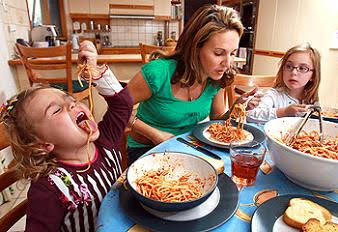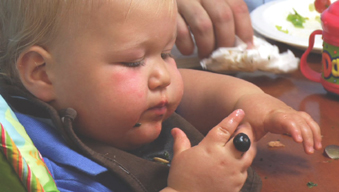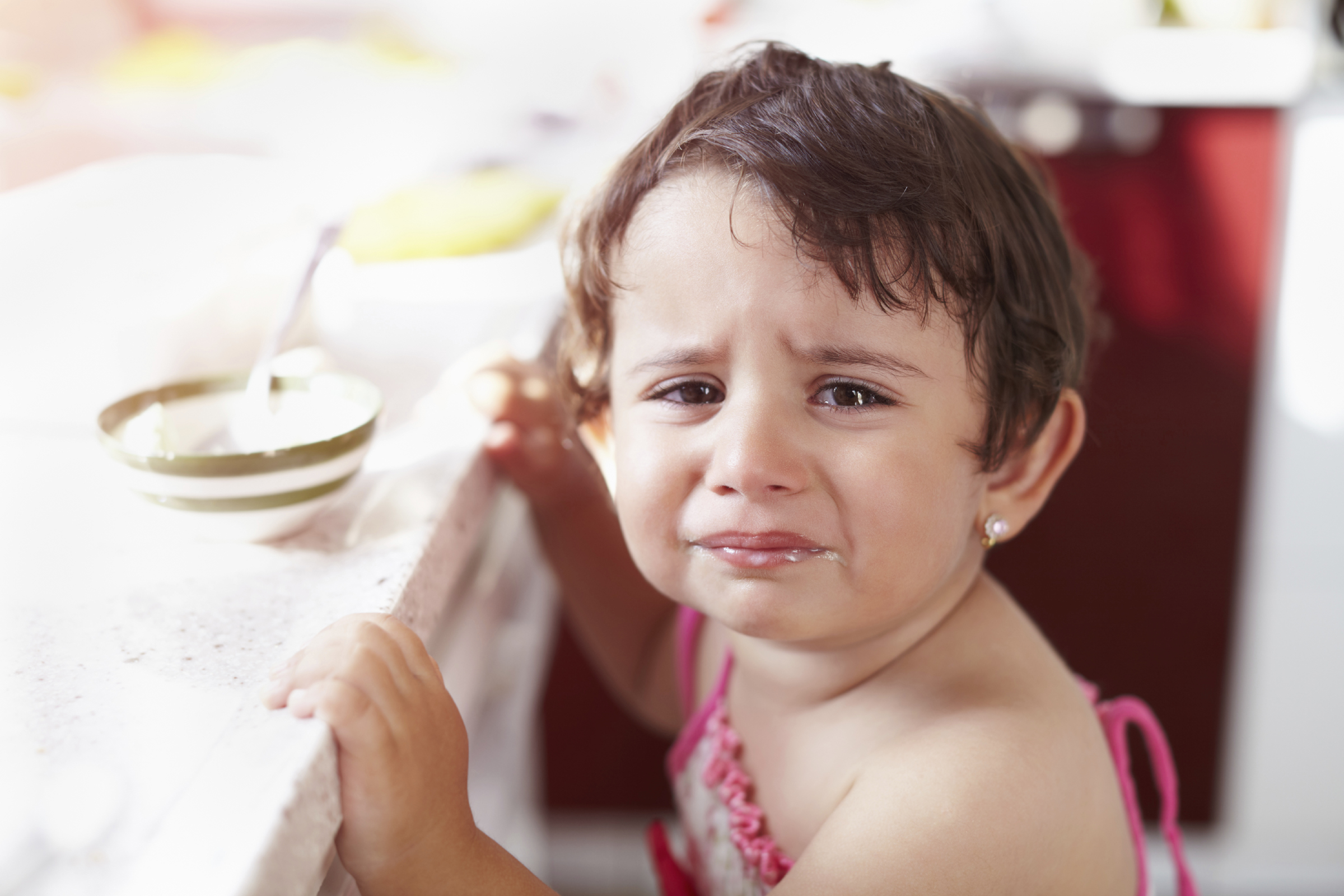
Feed your child with love and good sense
On this page
- Raise a healthy child who is a joy to feed
- Trust your child to grow in the best way
- Don’t panic about child overweight and obesity
- Keep your nerve with your small or slowly growing child
- Follow sDOR when your child has medical issues
- sDOR works for feeding children with special needs
- Troubleshoot when sDOR doesn’t seem to work
- Get help when you are stuck
Evidence for sDOR and the Satter Feeding Dynamics Model

Raise a healthy child who is a joy to feed
Step by step, throughout the growing-up years, your child learns to eat the food you eat and feel about eating the way you do. Starting with breast- or formula-feeding, learning to eat grown-up food, and joining in with family meals, your child becomes a part of the family with eating. Trying to get children to eat certain foods in certain amounts and grow in certain ways spoils family meals and makes everyone miserable. Parents who set aside the struggles are amazed at how much better they and their child feel and do, not only at mealtime, but all the time.
Do your jobs with feeding and let your child do his jobs with eating
Follow the Satter Division of Responsibility in Feeding (sDOR). You do the what, when and where of feeding and let your child do the how much and whether of eating.
- Trust your child to grow in the way that is right for him.
- Understand your child’s development. Feed—and parent—in the way that is right for each stage.
- Solve feeding problems by applying sDOR.
A good eater is a competent eater
Competent eating is about how your child feels and behaves around food, not about what and how much she eats. Your child wants to please you. When you follow the division of responsibility in feeding and give her the time she needs to learn and grow, she will eat the food you eat and behave nicely around food.
- She enjoys family meals—and you do, too.
- She eats as much or as little as she needs: Only she knows how much. Trusting her lets her be healthy and energetic and grow up to have the body that nature intended for her.
- She eats what you eat with only minor tweaking. She is okay with being offered food she has never seen before. She can sneak up on new food and learn to like it.
- She behaves nicely at mealtime: She picks and chooses from what you provide for the meal. She says “yes, please,” and “no, thank you.” She does not make a fuss.

Trust your child to grow in the best way
- Your child has a natural way of growing that is right for her.
- Her natural growth is in balance with her eating and moving.
- Maintain the Satter Division of Responsibility in Feeding and in Activity.
- Trust her to do her part with eating, moving, and growing.
It’s mostly about genes
Your child’s body shape and size are mostly inherited. The amounts she needs to eat are also inherited, and support her growing and moving in her own unique way. Even if her height and weight plot at the extreme upper or lower ends of the growth charts, she is growing normally as long as she grows consistently. Growth is only a problem if accelerates or falters: if it goes rapidly up or down from the usual growth curve.
Protect yourself and your child from interference
Don’t let anyone make an issue of your child’s size, shape or weight, and beware of hidden messages. Children who are encouraged to eat or move in a certain way to be “healthy” get the message that there is something wrong with their body. For a child, having a flawed body means she is is flawed in every way: not smart, not physically capable, and not worthy.
It ain’t over ‘til it’s over
You won’t know how your child’s body will turn out until toward the end of her teen years and even later for boys. Trying to control or change your child’s body will likely create the very outcome you are trying to avoid! As long as you keep your nerve and maintain the division of responsibility with feeding and with activity, your child’s growth may surprise you. The fat baby is likely to slim down. The small, ill, or growth-delayed child is likely to continue to do catch-up growth well into her teen years and has a good chance of being bigger than you may expect.

Don’t panic about child overweight and obesity
Child overweight and obesity are terms generally used to mean that children are too fat. They really mean children are too big – the designators – BMI – don’t distinguish between bigness and fatness. Often, children are classified as being “at risk” of overweight and obesity if parents are big. Your child might be big, but he is not too big provided he follows consistently along his growth curve, even it if is above the 95th or 97th percentile that many use to classify a child as obese. From the feeding dynamics perspective, a child’s weight is a problem only if it accelerates rapidly off his usual growth curve. Some kids are just big, and that is the way they are. Some parents are big, and that is the way they are. If you and your child are big and even fat, don’t panic and try to slim him down. To address real, imagined, or anticipated weight problems, follow the division of responsibility in feeding from birth. Let your child’s weight find its own level. Trying to get him to be thinner will make him fatter than he otherwise would be. Think about it: Did someone try to slim you down when you were little? Is it possible that, as a result, you are fatter than you would have been otherwise?
Be wary of the label
Don’t call your child overweight or obese, and don’t let anyone else do it either. Don’t even think it! Misery enters when weight becomes an issue. Kids who get the idea they are overweight feel bad in all ways: not smart, not physically capable, and not worthy. Studies show that children gain more weight, not less, when parents believe them to be fat. Parents do what they think is right and try to slim children down. That makes children afraid of going without, continually begging for food, and inclined to eat more than they even want when they can get it. Give yourself and your child a break! Follow the Satter Division of Responsibility with Feeding: Do your jobs with feeding, let your child do his jobs with eating, and let nature take its course.

Keep your nerve with your small or slowly growing child
The way to allow your small, slowly growing child to grow in the best way for her is to follow the Satter Division of Responsibility in Feeding (sDOR) from birth. The way to address growth faltering is to restore sDOR and let your child’s weight find its own level.
Your child may have been labeled too small or “failure to thrive” of her growth is below the third or even the fifth percentile. That is a scary term that means there is something wrong. Actually, if she grows consistently, nothing at all may be wrong with your child’s growth. But even without such labeling, parents worry when their child’s growth is extremely low or extremely high. But don’t let your worry make you put pressure on your child to eat. She will eat even less and grow even more slowly. Trying to change your child’s natural growth pattern will make everyone miserable and is unlikely to succeed.

Follow sDOR when your child has medical issues
You don’t need to abandon the Satter Division of Responsibility in Feeding (sDOR) in order to address your child’s medical issues. For your child with diabetes, maintain the structure and predictability of sDOR, depend on him to maintain his own energy balance, and adjust his insulin to cover what he eats. For your child with food allergies or sensitivities, focus on providing acceptable food rather than avoiding problematic food, and gradually teach your child to take responsibility for staying away from what makes him sick. For your child with cystic fibrosis, give him digestive enzymes, then trust him to eat enough to cover for his malabsorption.

sDOR works for feeding children with special needs
The Satter Division of Responsibility in Feeding works for children with special needs, even children learning to eat after being tube-fed. When you follow the division of responsibility and get help attending to any medical, nutritional, and oral-motor issues, even children with special needs push themselves along to learn to eat. But fragile children scare everyone, even experienced health professionals, and scared people pressure children to eat. That makes children behave like they don’t want to eat: uninterested in food, suspicious of unfamiliar food, upset about being offered anything new.
Let your child manage his own caution
Some children are naturally slow to warm up to tastes and textures. Children who have had painful medical procedures that involved their mouths, or negative early experiences around eating, are naturally cautious about new foods and new eating experiences. Children who have been tube-fed early on have missed out on early eating experience, and eating is all new to them. But even your slow-to-warm-up child wants to eat. After all, you eat, and she wants to grow up to be just like you!

Troubleshoot when sDOR doesn’t seem to work
Every child is unusual in some way. The Satter Division of Responsibility in Feeding (sDOR) applies to all children and applies to children of all ages, birth through adolescence. The problem is that some children’s characteristics and behaviors make it seem that they can’t be trusted to do their part with eating. They can. With some children more than others, sticking to the division of responsibility demands steady nerves and a leap of faith. If a child continues to be negative, upset, and anxious about eating, either structure is eroding or pressure and/or restriction is creeping in.
When you first start following sDOR, it takes a while to institute structure and let go of being controlling with what and how much your child eats. Once you get feeding organized, your child will have to test for a while to be sure you really will stick to structure and really will let him determine what and how much to eat from what you provide. But if you hang in there with doing your jobs and letting him do his jobs, your child will settle down. He will become relaxed and comfortable with eating and begin eating in his own normally quirky and erratic ways. Typically, once you get feeding in place, infants take a day or two to become relaxed and comfortable with feeding, toddlers a week, preschoolers 2 or 3 weeks, and school age children a month to six weeks.
However, keep in mind that that your child may not suddenly – or ever – eat the food you want him to eat or grow the way you want him to grow. sDOR lets him be relaxed and comfortable with eating so he can eat and grow in the way that is right for him. Stow your agenda, do your jobs with feeding, enjoy pleasant family mealtimes, and trust your child to do his jobs with eating.
Get help when you are stuck
Resolving feeding issues is important enough to merit an investment in time and money. You don’t have to spend years struggling with your child around feeding. You and your child both deserve to have a relationship around food that is relaxed and joyful. What can you do to find help?
- Look for a feeding dynamics professional. An Ellyn Satter Institute Faculty member or Associate may live near you. Alternatively, ask around. You may be able to find a professional who has been trained in feeding dynamics education and intervention by studying with Ellyn Satter Institute faculty members and/or demonstrated their expertise by taking ESI continuing education exams.
- Grow your own. Look for someone who understands how children grow and develop – in eating and in all ways – and is willing to learn right along with you. Together, you can Identify the causes of your child’s food refusal, make a feeding relationship plan, and help each other to be consistent and brave as you carry it out.
- Consider online coaching from ESI faculty members. Via Skype, telephone, and email, ESI faculty members do assessment, create a treatment plan just for you, and work with you as you institute that plan over several weeks.

